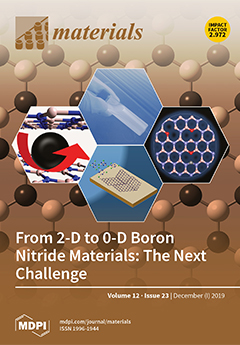The multi-spiked connecting scaffold (MSC-Scaffold) prototype with spikes mimicking the interdigitations of articular subchondral bone is an essential innovation in surgically initiated fixation of resurfacing arthroplasty (RA) endoprosthesis components. This paper aimed to present a determination of the suitable range of conditions for the calcium phosphate (CaP) potentiostatic electrochemical deposition (ECD
V=const) on the MSC-Scaffold prototype spikes to achieve a biomineral coating with a native Ca/P ratio. The CaP ECD
V=const process on the MSC-Scaffold Ti4Al6V pre-prototypes was investigated for potential V
ECDfrom −9 to −3 V, and followed by 48 h immersion in a simulated body fluid. An acid–alkaline pretreatment (AAT) was applied for a portion of the pre-prototypes. Scanning electron microscopy (SEM), energy dispersive X-ray spectroscopy (EDS) and X-ray diffraction (XRD) studies of deposited coatings together with coatings weight measurements were performed. Themost suitable V
ECD range, from −5.25 to −4.75 V, was determined as the native biomineral Ca/P ratio of coatings was achieved. AAT increases the weight of deposited coatings (44% for V
ECD = −5.25 V, 9% for V
ECD = −5.00 V and 15% for V
ECD = −4.75 V) and the coverage degree of the lateral spike surfaces (40% for V
ECD = −5.25 V, 14% for V
ECD = −5.00 V and 100% for V
ECD = −4.75 V). XRD confirmed that the multiphasic CaP coating containing crystalline octacalcium phosphate is produced on the lateral surface of the spikes of the MSC-Scaffold. ECD
V=const preceded by AAT prevents micro-cracks on the bone-contacting surfaces of the MSC-Scaffold prototype, increases its spikes’ lateral surface coverage, and results in the best modification effect at V
ECD = −5.00 V. To conclude, the biomimetic MSC-Scaffold prototype with desired biomineral coating of native Ca/P ratio was obtained for cementless RA endoprostheses.
Full article






